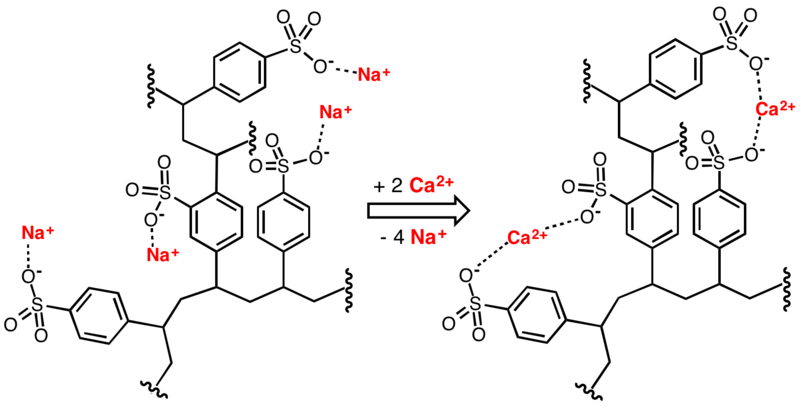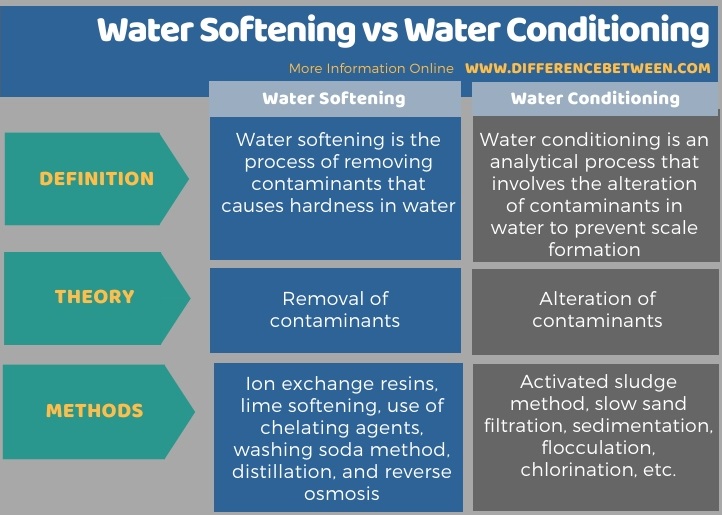Difference Between Water Softening and Water Conditioning
The key difference between water softening and water conditioning is that water softening involves the removal of scale from a water source, whereas water conditioning involves the alteration of scale from a water source.
Water softening and water conditioning are important analytical techniques in reducing the effect of scale formation in containers due to hardness in water.
CONTENTS
1. Overview and Key Difference
2. What is Water Softening
3. What is Water Conditioning
4. Side by Side Comparison – Water Softening vs Water Conditioning in Tabular Form
5. Summary
What is Water Softening?
Water softening is the process of removing contaminants that can give rise to hardness in water. Hard water is water that has a high mineral content. In general, hard water consists of a high content of magnesium and calcium minerals. These are dissolved minerals. The hardness of water is the measurement for determining whether water is hard or soft. Hard water is formed when water flows through limestone and chalk, which are made up mainly of magnesium and calcium carbonates.
Soft water is water that has lower mineral content. Soft water is free of dissolved salts of calcium and magnesium. Soft water mainly contains sodium ions. Soft water is treated to have only sodium cations. Its water may not be suitable for drinking because of the less mineral content and salty taste. Soap is highly effective on soft water and forms foam when used.

Figure 01: Exchange of Ions with Resins
There are several methods that can be used to remove hardness from water. Some of the common methods include the use of ion exchange resins, lime softening, use of chelating agents, washing soda method, distillation, and reverse osmosis. Among them, the most efficient methods are the ion exchange method and the reverse osmosis method.
In the ion exchange resin technique, the metal ions that cause hardness in water, i.e., calcium ion and magnesium ion, are exchanged with sodium ions in the resin. Sometimes, this technique uses potassium ion-containing resins as well. These resins are organic polymer compounds. On the other hand, the reverse osmosis technique uses a pressure gradient applied across a semi-permeable membrane in order to overcome the osmotic pressure.
What is Water Conditioning?
Water conditioning is an analytical process that involves the alteration of contaminants in water to prevent scale formation. But, this does not involve the removal of a chemical species. Also, this technique concern three major issues in water: limescale, bacteria, and algae. These contaminants can cause host issues in water systems including pipes, heat exchangers, on fixtures, etc. Water conditioning is mainly used for industrial purposes.
The water conditioning process improves the corrosion control in the boiler water. And, this is through pH controlling, oxygen controlling, and storage controlling. The major benefits of water conditioning include the followings:
- Reduction of scaling
- Reduction of impurities
- Improving the taste and odour of water
- Improving the water quality
- Reduction of operating costs in industrial applications
Methods we can use for water conditioning include physical techniques such as filtration, sedimentation, and biological processes such as slow sand filters, activated sludge, and chemical processes such as flocculation and chlorination.
What is the Difference Between Water Softening and Water Conditioning?
The key difference between water softening and water conditioning is that water softening involves the removal of scale from a water source, whereas water conditioning involves the alteration of scale from a water source.
The following table summarizes the difference between water softening and water conditioning.

Summary – Water Softening vs Water Conditioning
Water softening and water conditioning are important analytical techniques for reducing the effect of scale formation in containers due to hardness in water. The key difference between water softening and water conditioning is that water softening involves the removal of scale from a water source, whereas water conditioning involves the alteration of scale from a water source.
Reference:
1. “Softening.” Luminor, Available here.
2. “Water Softening.” Wikipedia, Wikimedia Foundation, 13 Mar. 2020, Available here.
3. “Water Conditioner vs. Water Softener.” Residential Blog | HydroFLOW USA, Available here.
Image Courtesy:
1. “CationExchCartoon” By Smokefoot – Own work (CC BY-SA 3.0) via Commons Wikimedia
ncG1vNJzZmivp6x7pbXFn5yrnZ6YsqOx07CcnqZemLyue8OinZ%2Bdopq7pLGMm5ytr5Wau27DwK2cq2WjpLO1sc2ipaBlkaOxbsPArZyrZZOku6W106Kmp6GenHw%3D